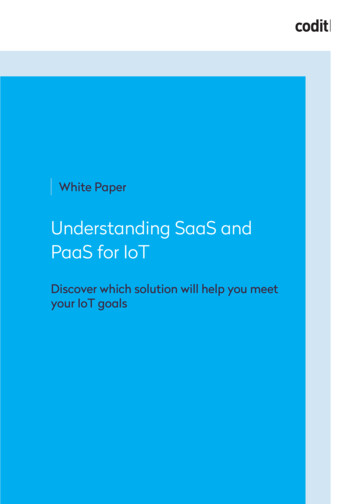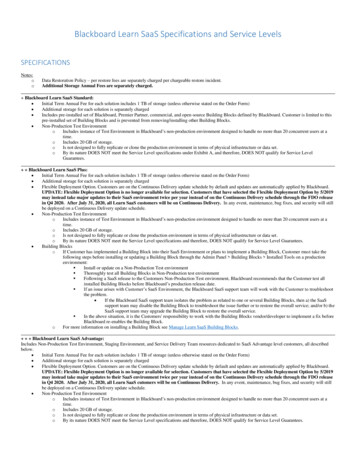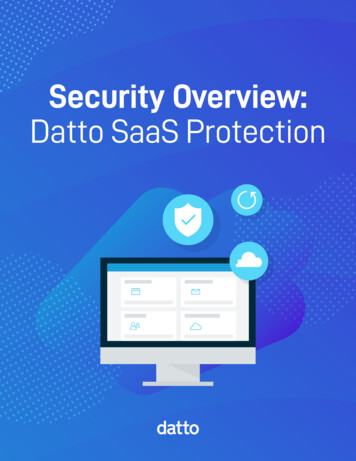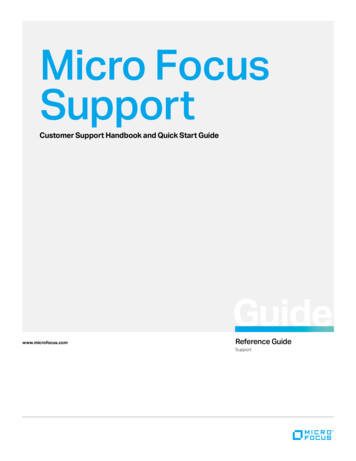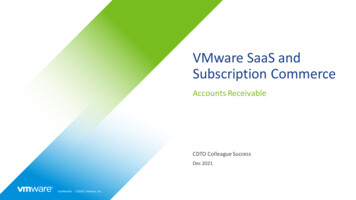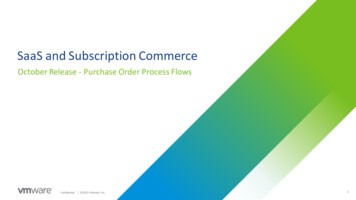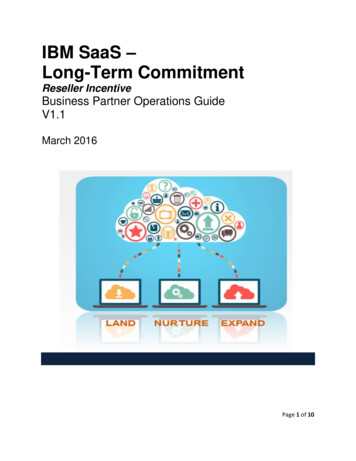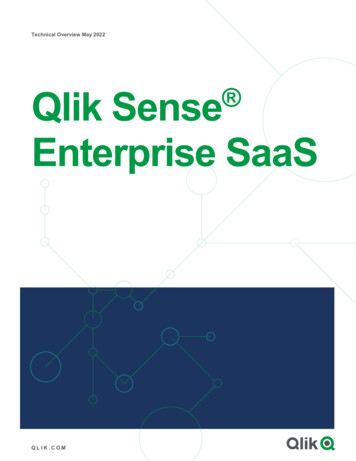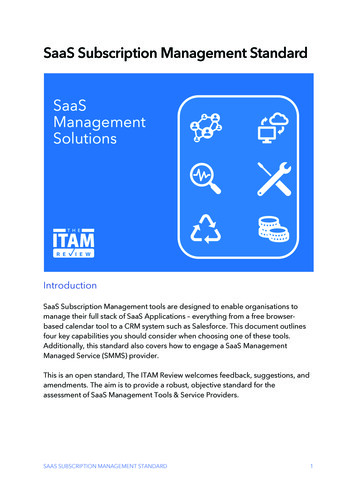
Transcription
SaaS Subscription Management StandardIntroductionSaaS Subscription Management tools are designed to enable organisations tomanage their full stack of SaaS Applications – everything from a free browserbased calendar tool to a CRM system such as Salesforce. This document outlinesfour key capabilities you should consider when choosing one of these tools.Additionally, this standard also covers how to engage a SaaS ManagementManaged Service (SMMS) provider.This is an open standard, The ITAM Review welcomes feedback, suggestions, andamendments. The aim is to provide a robust, objective standard for theassessment of SaaS Management Tools & Service Providers.SAAS SUBSCRIPTION MANAGEMENT STANDARD1
Table of ContentsIntroduction . 1Essential Tool Requirements . 2Discovery . 3Questions for providers of Discovery tools: . 3Inventory . 4Questions for providers of Inventory Tools. 4Normalisation. 5Questions regarding Normalisation capabilities . 5Optimisation. 5Common Requirements . 5Cost Management Questions & Requirements . 6Risk Management Questions & Requirements . 7Automation Questions & Requirements . 8Questions for Managed Service Providers . 9Bibliography . 10Essential Tool RequirementsThe SaaS Optimisation lifecycle is similar to that for perpetually licensed software.We need to Discover what’s in use, create an Inventory, Normalise that inventory,and Optimise our estates.DiscoverOptimiseInventoryNormaliseSaaS Subscription Optimisation LifecycleSAAS SUBSCRIPTION MANAGEMENT STANDARD2
The difference is largely in the techniques used – and also, critically, the time torealise value. Good foundational discovery and inventory enables optimisationactivity at a pace impossible in perpetually licensed environments.Let’s look at the tool requirements for each stage of the SaaS SubscriptionOptimisation Lifecycle.DiscoveryDiscovery can be a challenge in SaaS environments. There’s often nothinginstalled, and in 70% of deployments (by value) the budget is coming from Line ofBusiness (LOB) departments, not central IT.1 Everyone is potentially an acquirer ofSaaS services and recent research finds that half the SaaS estate has beenacquired via employee expense accounts.1 As such, your usual processes forcapturing new entitlements and adding them to your existing ITAM toolset won’twork here. The problem is exacerbated by the frictionless nature of SaaS, with 39%of a company’s SaaS stack changing annually.2 And with SaaS spending growingso rapidly (164% since 2016)3 it is vital that you know where that spend ishappening.Scale is also a factor – the same research finds that the average company is using597 SaaS apps. Every one of those apps has the potential to be a security risk or togenerate unplanned and unbudgeted costs. How do you go about onboarding anew employee with the right tools with so many to deploy?To cope with this scale and the multiple entry routes into your environment, a SaaSSubscription Optimisation toolset needs to approach discovery from multipleangles. For example, one that relies on integrations to your expense andaccounting systems won’t discover the multitude of free apps. And one thatconsumes data from your corporate single-sign-on application won’t find appsthat don’t use it. You may also need to consider the use of corporate SaaS apps onunmanaged personal devices.Questions for providers of Discovery tools:1. Which Discovery capabilities does your tool make use of (e.g. API, SSO,Expenses, Agent)2. Does the tool detect free SaaS apps?3. Which accounting and expense systems does it work with?4. Which Single Sign On (SSO) providers does it consume data from?SAAS SUBSCRIPTION MANAGEMENT STANDARD3
5. Which SaaS applications does it directly interface with?6. Does it require an agent or similar technology to be deployed?7. Can it differentiate between personal and corporate usage of SaaS apps?InventoryDiscovery capabilities answer questions such as “What do we own” and “What arewe using”. Building on that, Inventory gets you rich data about the things you’vediscovered. If Discovery is finding the treasure chest, then Inventory is finding outwhat’s inside. As with the Discovery process, SaaS Inventory is likely to require amulti-vector approach. For example, you may discover that 20 employees areexpensing the conferencing app Zoom via an expense system integration. Thepurpose of inventory is to determine which of those employees is actively usingthe application, for how long, and perhaps even with whom.Most SaaS Optimisation tools blur the lines between Discovery and Inventory. Forexample, if a tool has a Salesforce connector, that connector may simultaneouslyfind the subscription and provide the rich metrics around usage data you require.However, it is still worthwhile to probe the differences with a prospective toolprovider.Questions for providers of Inventory Tools1. Request a full list of inventory data fields captured by the tool (e.g. user,email address, timestamps, application version/edition, location, deviceused)2. Confirm options for querying inventory data – static reports, dashboards,APIs, connectors to other IT Management systems such as a traditionalITAM toolset.3. Does the tool gather rich usage data? For example, first used, last used,length of time used, features & capabilities used.4. Integration options with multiple discovery tools. For example, can thesystem receive data from an expense system discovery and merge that withdata from your Single Sign On provider?5. Can the tool be integrated with other IT Management applications such as aCMDB or an ITAM tool designed for managing on-premises deployments?SAAS SUBSCRIPTION MANAGEMENT STANDARD4
NormalisationThe purpose of normalisation is to bring together discovery and inventory datafrom multiple sources. For example, you might gather usage data from a SaaSprovider’s portal, find a contract for that SaaS provider from your expenses oraccounting system, and gather a user list from an HR or User AccountManagement system. The output from normalisation is certainty or confidenceabout the usage of SaaS applications in your estate.Questions regarding Normalisation capabilities1. Does the tool categorise applications according to metrics such asapplication type (e.g. web-conferencing, file-sharing)?2. Does the tool categorise applications according to who is using them (e.g.Marketing, Sales, Engineering)?3. Does the tool identify product owners automatically? Product owners willbe the lead contact in your organisation for the tool.4. Does the tool provide insight into Discovery & Inventory data quality? Forexample, by highlighting which inventory and discovery data methods havecontributed to an application catalogue entry. This is particularly importantfor large estates in the upcoming Optimisation lifecycle stage.5. Does the tool have the ability to provide insight into “known unknowns”?For example, if you have discovered an estate-wide commitment to Office365 but have only inventoried usage by one department does it highlightthat discrepancy?OptimisationOptimisation is the desired outcome of investing in a SaaS SubscriptionManagement tool.This section has key questions for tool providers split between the three primaryoptimisation use cases – Cost Management, Risk Management, & Automation –along with a section on common requirements.Common RequirementsThis section covers requirements/questions common to all optimisation use cases.So far, this standard has focused on capabilities relating to identifying what’s inuse in an estate. In order to begin to optimise, we need to combine our new-foundSAAS SUBSCRIPTION MANAGEMENT STANDARD5
knowledge of what we’re using (through discovery, inventory, and normalisation)with entitlement (what we own).In comparison to perpetual licensing, this is an area where SaaS works slightlydifferently and blurs the lines. For example, many SaaS Subscription Managementtools include entitlement information as part of their Discovery and Inventorycapabilities. Top-tier SaaS apps such as Office 365 & Salesforce contain thisinformation in their management portals.However, we still need a means of adding entitlement information and other datato our tool, in order to carry out optimisations. With that in mind, here are somekey questions on common optimisation requirements.1. Does the tool enable manual input of entitlement data?2. Which data fields relating to entitlement does the tool support?3. Does the tool provide automatic entitlement import for the SaaS apps youwant to manage?4. Does the tool enable batch import of entitlement information – for examplefrom other tools or your own records such as procurement or financeapplications?5. Does the tool enable import of user records from systems such as HR orUser Account Management?6. Does the tool retain audit records for the manipulation of imported data?7. Does the tool enable import and management of an organisationalstructure?8. Does the tool enable import of accounting information such as cost centres& expense codes?Cost Management Questions & RequirementsCost Management may be the primary driver for SaaS Subscription Management.On average, tool vendors estimate around 35% of SaaS spending is wasted, soeffective capabilities in this area will enable rapid ROI on your subscriptionmanagement tool.1. Does the tool enable allocation of SaaS expenditure to departments, users,and other organisational structures?2. Does the tool support multi-currency entitlement recording?SAAS SUBSCRIPTION MANAGEMENT STANDARD6
3. Does the tool provide a renewals calendar, with configurable alerts?4. Does the tool identify unused subscriptions based on the appropriatemetric for the subscription? For example, identify users who haven’t usedthe application for 90 days.5. Does the tool identify fine-grained usage of the application? For example,creation and editing of a Word document, rather than having just openedWord to read a document.6. Does the tool make recommendations for re-allocation of subscriptions inresponse to onboarding requests for new users?7. Are optimisation insights actionable? For example, one-click deprovisioning of unused subscriptions.8. Does the tool support user profiling? For example, identifying common appusage per role profile, and highlighting non-standard usage forinvestigation.9. Does the tool identify duplicate capabilities per subscriber? For example,highlight users with paid subscriptions for Zoom, GoToMeeting, andWebEx.10. Does the tool provide the ability to survey users regarding app suitability?For example, ask users whether they would recommend the application andgenerate a Net Promoter Score (NPS).11. Does the tool provide forecasting and budgeting capabilities? For example,monthly, annual, multi-annual forecasts.Risk Management Questions & RequirementsRisk Management capabilities are emergent differentiators for SaaS SubscriptionManagement tool vendors. As the regulatory landscape shifts and puts a greatercompliance burden on organisations, Risk Management increases in importance.SaaS is particularly susceptible to risk in comparison to on-premises softwarebecause nothing is installed, the application runs on the service provider’scomputing resources, and private customer data is similarly placed in cloudstorage.The following questions will define the risk management capabilities of your SaaSSubscription Optimisation toolset.SAAS SUBSCRIPTION MANAGEMENT STANDARD7
1. Does the tool enable blacklisting/whitelisting of SaaS applications? Arethose lists configurable by department, deployment location, user role, orprofile?2. Does the tool report on the compliance certification status of a SaaSapplication? For example, SOC2 compliance4.3. Does the tool profile users, highlighting common applications by role, andidentify potentially unusual application activity?4. Does the tool identify potentially harmful application permissions? Forexample, a travel scheduling application that has been granted fullread/write access to a corporate email account.5. Does the tool track vendor data breaches and other reportable securityincidents?6. Does the tool enable rapid security incident response? For example,enabling central notification to users to prevent use of a compromisedapplication.7. Does the tool report on the overall security standing of a SaaS application?For example, reporting on whether the application supports two-factorauthentication8. Does the tool produce a report of SaaS application rights retained by userswho have left the organisation?9. Does the tool provide an authorisation record/audit trail fordeployment/removal of SaaS applications?Automation Questions & RequirementsFor a large SaaS estate, Automation is an enabler for both Cost Control and RiskManagement. For example, integration with HR systems can be used toautomatically provision and de-provision SaaS accounts for new hires and leaversrespectively. Failing to de-provision leavers is a significant source of risk, withresearch indicating 89% of ex-employees retain access to SaaS apps one monthafter leaving.51. Does the tool enable creation of standard profiles for certain employeetypes? For example, a list of applications required by a Customer Servicerepresentative.SAAS SUBSCRIPTION MANAGEMENT STANDARD8
2. Does the tool provide employee self-service for provisioning apps? Forexample, integrating with SaaS vendor portals to automatically allocateaccounts.3. Does the tool automate the removal of SaaS subscriptions from exemployees?4. Where direct automation isn’t possible does the tool integrate with HRand/or User Account Management systems to provide a checklist foraddition/removal of SaaS applications?5. Does the tool detect unused applications and automatically remove thosesubscriptions?Questions for Managed Service ProvidersWhat if you don’t have a dedicated ITAM team, or consumption managementteam, or the necessary skills in house to manage your SaaS spend? This is whereengaging a SaaS Management Managed Service (SMMS) can help. Some toolvendors already offer such services as part of their offering, and there are alsopure managed-service offerings available too.Questions for SMMS providers are broadly similar to those above. From atechnical perspective their service needs to be able to integrate with your systemsof record to Discover, Inventory, Normalise, and Optimise your SaaS spending.From a service engagement perspective these additional questions are pertinent.1. What is your pricing model?2. Do you also sell SaaS subscriptions?3. Are you a partner of X (where X is the vendor of most importance to yourcompany). The aim of this question is to uncover any potential conflict ofinterest – for example, is a Salesforce Partner best-placed to optimise yourSalesforce estate?4. Where is my company data stored and processed?5. Do you assign a dedicated point of contact to us?6. What is the expected time to value of an engagement?7. What experience do the consultants assigned to us have in managing ourkey products?8. In the event of service termination, what happens to my company’s data?9. Do you use my company’s data for purposes other than optimising myestate?SAAS SUBSCRIPTION MANAGEMENT STANDARD9
Bibliography1. 2019 SaaS Benchmarks. essed August 16, 2019.2. Witt A. Frictionless SaaS - Trends for 2019. ITAM Rev. March frictionless-saas-trends-for2019/. Accessed August 15, 2019. From http://www.blissfully.com3. The State of Business’ SaaS Spend 2019 Cleanshelf. Cleanshelf The Systemof Record for Your Cloud 13/the-state-of-business-saasspend-2019/. Accessed August 16, 2019.4. SSAE 16. In: Wikipedia. ; 2019.https://en.wikipedia.org/w/index.php?title SSAE 16&oldid 898377216.Accessed August 19, 2019.5. The ex-employee menace: 89% retain access to Salesforce, QuickBooks &other sensitive corporate apps. ooks-othersensitive-corporate-apps. Accessed August 20, 2019.SAAS SUBSCRIPTION MANAGEMENT STANDARD10
with entitlement (what we own). In comparison to perpetual licensing, this is an area where SaaS works slightly differently and blurs the lines. For example, many SaaS Subscription Management tools include entitlement information as part of their Discovery and Inventory capabilities. Top-tier SaaS apps such as Office 365 & Salesforce contain this


